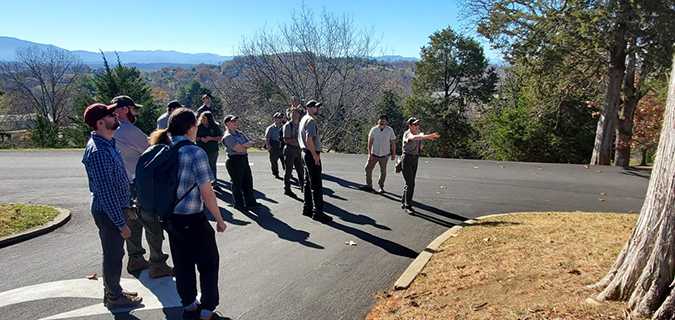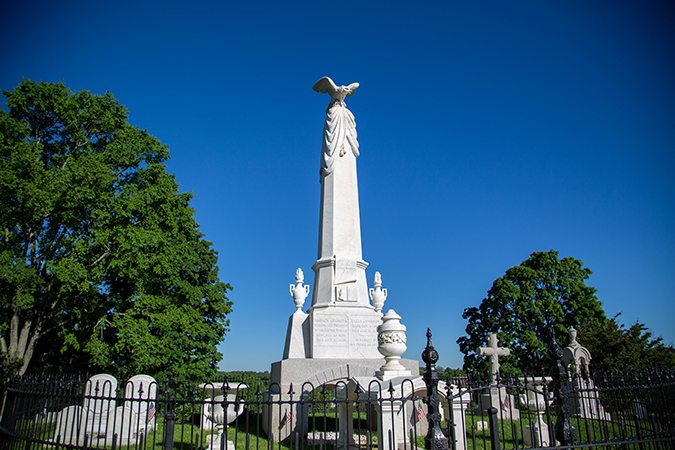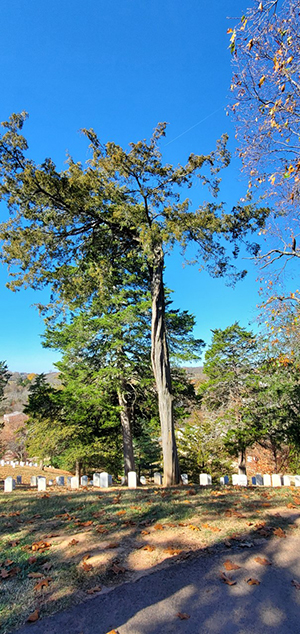| |
Managing Andrew Johnson National Cemetery for future generations
December 16, 2022; 5:17 p.m.

Susan Dolan, Parks Cultural Landscape Program Manager, speaks to park staff and the landscape assessment team; image by NPS
|
GREENEVILLE, TN -- When most think about the Andrew Johnson National Cemetery, few consider the individual shrubs and trees. True they do make up the background ambiance that fosters a calming, almost serene feeling in those who visit. What few know is that this is by design, not mere happenstance.
National Cemeteries were designed from the onset to evoke feeling of respect for America’s fallen soldiers. Created by an Act of Congress in July 1862, National Cemeteries were established for the burial the Union dead. By the end of the Civil War, 12 national cemeteries had been created and by 2022, the system evolved into a collection of 163 cemeteries throughout the country and its territories, with most being administered by the National Cemetery Administration, itself an agency of the U.S. Department of Veterans Affairs.

An Eastern Cedar showing the ravages of time and the elements; image by NPS
|
Most, but not all! Andrew Johnson National Cemetery is one of fourteen national cemeteries managed by the National Park Service. Andrew Johnson National Cemetery was established in 1906, shortly after our 17th President’s oldest surviving daughter – Martha Johnson Patterson, willed Signal Hill, where her parents were buried, to the War Department to be used as a resting place for veterans.
When planning for the national cemetery in Greeneville, TN, the War Department applied its standards to this cemetery as they had in other national cemeteries, most notably encircling it with a perimeter wall with an ornate entry gate; the creation of a cemetery-keeper’s quarters; and the creation of a commemorative landscape befitting the honored dead. To achieve the latter, the War Department used certain tree species, such as Norway Spruce, American Holly, American Elm, and Eastern Cedars. When carefully cultivated and managed, these species projected a calming sense of peace, befitting a final resting place. Their rugged sturdiness and majestic trunks & canopies, especially when arrayed in uniformity, also projected strength and respect - attributes reflecting those buried there.
| |

Eastern cedar tree; image by NPS
|
Challenges not envisioned by the War Department, include climate change, insect-kill, and the proliferation of invasive plant species. The gradual warming of the environment has affected many of the tree and shrub species once so common throughout cemetery. The effects of storms and even bug infestations have marred other historic trees along the grounds.
To combat these challenges, while preparing for the future, Andrew Johnson National Historic Site hosted a group from the National Park Cultural Landscapes Program in November to assess the condition of the historic features of the cemetery – its facilities, wall, and landscape, and to identify any work needed for preservation. Specialists included a stonemason, arborist, horticulturalist, and landscape architect.
Using Geographic Information Systems mapping equipment, and old-fashioned tape measures, the team assessed the cemetery landscape, and found that both the perimeter wall and monuments were in good condition, but the opposite was true of the trees and shrubs. These were determined to need preservation efforts.
Tree species that once prospered here are facing increasing threats and some species can no longer thrive today. Eastern Hemlock and Ash trees that once graced the cemetery are susceptible to pests in the increasingly warmer climate. Most of the Ash have been lost due to Emerald Ash Borer and the Eastern Hemlock suffer from Woolly Adelgid and Elongate Hemlock Scale. The Cultural Landscape Team recommended replacing these imperiled tree species with White oak, Holly, and Eastern Red Cedar – which are more resilient.
The green lawn of the cemetery, a balance of dry and water-dependent grass species, is now subject to invasive plants such as Carolina Horse Nettle and mallow. The teams recommended aeration of the soils and overseeding to combat the invasive plants. A careful combination of aeration and nutritional mulching was recommended for some of the older trees, while pruning and dead limb-removal was recommended for others.
The goal of the project was to assess the cemetery landscape and recommend actions that would improve the density and quality of the plants and trees that are an important part of it. Overall, the team found that the Andrew Johnson National Cemetery to be in relatively good shape. Though the future may present challenges that might impact this nationally significant landscape, staff at Andrew Johnson National Cemetery will continue to protect and preserve this place of honor for future generations.
Andrew Johnson National Historic Site is one of over 423 parks in the National Park System. To learn more about parks and the National Park Service programs in America’s communities visit www.nps.gov.
|

